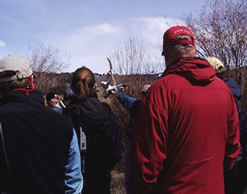Self-Guided Discovery Pathways through the Yellowstone Geoecosystem
About the Yellowstone Geoecosystem

Yellowstone National Park (YNP) is one of the greatest natural laboratories for exploring the interactions between the physical world, biota, and humanity. Yellowstone is the world's first national park, and is also a designated World Heritage Site and a Biosphere Reserve Site. The park encompasses 3,472 square miles, including geologic formations that range from Archean basement to Pleistocene glacial deposits; it is a living volcano that has formed one of the world's largest calderas and hosts the world's largest geothermal area; it is home to 50 species of mammals including endangered or threatened grizzly bears, gray wolves, lynx and bald eagles, 1700 species of vascular plants, and uncounted species of microbes living in the extreme environments of Yellowstone's hot springs; and, it welcomes nearly 3,000,000 human visitors per year(YNP Fact Sheet (more info) ).
The mission of the National Park Service (NPS) is:
"...to promote and regulate the use of the...national parks...which purpose is to conserve the scenery and the natural and historic objects and the wild life therein and to provide for the enjoyment of the same in such manner and by such means as will leave them unimpaired for the enjoyment of future generations."
National Park Service Organic Act, 1916
These principles have set forth a difficult mission for the NPS: to simultaneously conserve and preserve natural resources in the park while promoting the use and enjoyment of the park by the public. This webpage was developed to encourage users to explore for themselves the complex interrelationships within the Yellowstone Geoecosystem and the issues related to use and management of YNP resources. Not everyone will be fortunate enough to travel in person to YNP, but these digital pathways will hopefully reveal interesting and important scientific discoveries about the Yellowstone Geoecosystem and how scientific investigations inform park policy and management.
Learning About the Yellowstone Geoecosystem in an Earth System Context

The collection of resources in Exploring the Yellowstone Geoecosystem provides a wealth of information to support learning about this unique place on Earth. This web-mediated learning environment allows learners to readily follow lines of inquiry between related topics, or to dig deep to comprehensively investigate a single topic of interest.
Visit Teaching with an Earth System Approach from the Starting Point project for a more complete description of Earth system science, learning resources, and instructional strategies.
Where to start?
Garrett Hardin's First Law of Ecology , (and by extension, of Earth system science) is, "Everything is connected to everything else". The Yellowstone Geoecosystem offers something of interest for nearly everyone. Once you've "entered" the Yellowstone Geoecosystem, it doesn't really matter where you start because the relationships between all the components become readily apparent. So, start with something you've wondered about, or choose a topic you've heard about in the news. Motivation for learning is often rooted in activities that are goal-directed, where the task demonstrates knowledge or skills, or that elicits curiosity (see Edelson, 2001 ). Here are some suggested self-guided discovery pathways to explore the Yellowstone Geoecosystem that will hopefully motivate learning by promoting a sense of wonder and curiosity or by creating a compelling need to know. Use these links to find the evidence to address suggested questions, and to develop and pursue your own questions!
Start with "A Living, Breathing Volcano".


Start with Yellowstone Science
Yellowstone Science (more info) is a quarterly publication devoted to Yellowstone National Park's natural and cultural resources. It features articles about research in the park, provides a colloquium for scientists, and offers an opportunity for the public to view this research. Articles can be searched by topic, author, or volume and may be downloaded in PDF format. This source reveals some of the most exciting new science that's being done in the Park. Use these research projects as the starting point to make connections across the Yellowstone Geoecosystem using the additional resources provided in our digital collections.
Start with a Current Issue About the Park

Start with the Cultural Heritage of Yellowstone

These are just a few suggested pathways to explore this amazing natural laboratory. Enjoy the journey through the Yellowstone Geoecosystem.
